Rinoseptoplasty is a surgical method to correct the shape of the nose or to restore the nasal septum. Plastic surgery has several secondary names: nose plastic, shape correction, volume correction. This correction method is already more than 3 thousand years old.
What is rhinoseptoplasty
Rhinoseptoplasty involves the cartilaginous skeleton of the nose. The purpose of the operation is to return it to the correct form. The nose is an organ of smell and plays an important role in the development of the human respiratory system. It is a regulator of air ventilation, as well as one of the parts of the tear duct system.
Therefore, rhinoseptoplasty is performed as a complex operation for violations in the activity of the organs of vision. Rinoseptoplatsica is considered one of the most difficult operations in the field of maxillofacial surgery. This is due to the anatomical structure of the nose, the individual location of the nasal septum.
A septum is a plate that divides the nose into 2 parts. In most people, the plate is curved, which is a consequence of the asymmetry of the skull. Minor deviations are considered normal, provided that they do not cause a violation of nasal breathing.
Problems with the nasal cavity are also associated with the region of residence of a person:
- residents of warm regions have wide noses due to the accelerated heat transfer of air;
- the inhabitants of the northern regions have narrow wings of the nose: the air passing through the nasal passages in small portions takes longer to heat up.
These small nuances are taken into account when prescribing rhinoseptoplasty.
Indications
Rinoseptoplasty is a surgical intervention that is performed upon reaching the age of 20, when the organ becomes fully formed and does not undergo further growth and development. The optimal period for rhinoseptoplasty is from 20 to 35 years.
The main indications for the operation are:
- A hump on the back of the nose. This is an aesthetic problem. Plastic surgeons call it one of the most common reasons for treatment. The hump of the nose are congenital in nature, but can be the consequences of injuries to the maxillofacial system.
- Thickened nose bridge. It is a congenital defect but can develop after facial trauma. To correct the thickening, surgeons remove small areas of the nasal bone.
- Nasal saddle shape. This problem is characterized by the sinking of the nasal back, whereby the tip of the nose may be raised. There are different saddle forms: from mild to severe with retraction of large areas of the nose. Such consequences often appear after a number of plastic surgeries on the face using Botox injections.
- Curvature of the side of the nose. Lateral deformity is most often the result of severe facial trauma.Such a birth defect is usually corrected in childhood, when the cartilage is not fully formed and amenable to influence.
- Disproportionate nose. In this case, an operation is performed with the aim of giving the nose an aesthetically correct appearance. This category includes corrections of the irregular shape of the tip of the nose, which can have different shapes: from hooked to forked and pointed.
- Correction of the wings of the nose. This indication is singled out as a separate one, because the surgery to correct the wings of the nose has distinctive features. In this case, the bones of the nose are not affected, only the lower lateral parts are affected.
- Inflammatory process in the sinuseswhich is chronic. This indication has nothing to do with the canons of beauty, it is necessary in nature. Its purpose is to eliminate breathing problems. The cause can be chronic sinusitis. It is characterized by the development of complications.
- Recurring regularly otitis media. This is an inflammation of the middle ear, which is often repeated due to the anatomical and physiological characteristics of the nasopharynx. After a complete examination, doctors prescribe rhinoseptoplasty to correct this error.
- Difficulty in nasal breathing, persistent nasal congestion. Rinoseptoplasty is used to solve this problem in the event that nasal breathing is impaired due to a significant curvature of the nasal septum.
- Difficulty in the outflow of tear fluid. This indication is associated with an abnormal structure of the nasal septum. Fixing it will usually fix the churn problem. The lacrimal fluid should not linger, otherwise it can provoke serious complications, such as: an abscess of the eyelids or phlegmon of the organs of vision.
- Perforation of the nasal septum. The appearance of holes of different sizes in the plate leads to breathing problems. The disorder develops due to injuries, fractures, and also as a consequence of the use of drugs.
- Dacryocystitis. This is a disease characterized by inflammation of the lacrimal sac. A common cause for dacryocystitis is the curvature of the nasal septa, which is associated with obstruction of the nasolacrimal canal. A purulent fluid forms in the lacrimal sac, which flows out when pressed. Rinoseptoplasty is performed in combination with surgical interventions for the lower and upper eyelids.
Contraindications
Rinoseptoplasty is a surgical procedure that may be contraindicated in some cases. This should be taken into account when planning the operation, both for patients and for plastic surgeons.
- Age restrictions. Operations to correct the nose are not done until the age of 20, with the exception of cases of serious injuries after an accident. Old age is also a contraindication for rhinoseptoplasty. Surgeons advise avoiding surgery after 40 years, during this period the risk of complications associated with the sinking of the nasal parts increases. Also, the wound healing time increases and the rehabilitation process becomes more complicated.
- Diabetes mellitus of both types. Diseases associated with disorders of the endocrine system are considered a direct contraindication to the appointment of surgical manipulations. Problems with blood counts can become a serious obstacle to complete rehabilitation and prevent healing.
- Folliculitis in the nose. Inflammation of the skin with the formation of purulent papules can lead to complications after surgery, therefore, for rhinoseptoplasty, folliculitis is eliminated and a quarantine period is established after it.
- Liver, kidney disease. The risk of developing complications after surgery in people with serious liver or kidney disease is increased several times.Withdrawal of drugs, which are required for surgical operations through the kidneys and liver, is difficult and often leads to complications, therefore, doctors do not recommend rhinoseptoplasty for chronic pyelonephritis or cholecystitis.
- The presence of cancer. This type of surgery is prohibited for those who are actively developing tumor formations. Rinoseptoplasty can lead to the further development and multiplication of cancer cells.
- Diseases of the cardiovascular system. The effect of drugs on the heart and blood vessels during a possible rhinoseptoplasty exceeds the permissible norms, therefore, surgery is contraindicated in patients with blood flow disorders.
- Mental disorders. The operation can provoke an exacerbation of disease. In addition, people with nervous disorders should avoid exposure to anesthesia.
- Pregnancy. During this period, rhinoseptoplasty is not performed.
- Acute viral disease. In the course of such diseases, viruses spread inside living cells. The consequences of surgical intervention against the background of a developing virus are unpredictable and irreversible.
Types of operations
Rinoseptoplasty is an operation that is divided into types depending on the methods of manipulation:
- Endoscopic. The purpose of the exercise is recovery.
- Laser. It is carried out using the latest equipment.
- Open. Carried out under general anesthesia, the goal may be multiple tasks of adjustment or replacement.
- Closed. The disadvantage of this method is the inability of the surgeon to see the structure of the nasal cartilage, he is forced to act blindly.
Preparing for surgery
Rinoseptoplasty is planned in advance.
For preparation, the patient must provide the results of the following examinations:
- clinical analyzes of blood and urine;
- cardiogram;
- fluorography.
In the presence of chronic diseases, it is necessary to carry out a stabilization course, to take measures to eliminate possible complications.
After consultation with a plastic surgeon, it is necessary to conduct a computed tomogram of the nasal septum to provide the doctor with a complete picture of the structure. In individual cases, additional examinations are required, the provision of the necessary X-ray images.
How is rhinoseptoplasty and the rehabilitation period
The process of performing rhinoseptoplasty depends on its type and purpose. Modern clinics offer to carry out computer simulations before making a decision. It allows you to evaluate the intended result.
Endoscopic
Characteristic features of endoscopic septoplasty:
- period of about 2 hours;
- general anesthesia;
- manipulations with an endoscope.
During the operation, an incision is made, then the cartilage is isolated, the deformed parts are cut off. After that, the nasal septum is fixed. The last step is the introduction of a turunda into the nasal passages to prevent bleeding and support the septum.
A feature of endoscopy is the use of cartilage from the auricles to correct the nasal septum, change or enlarge the cartilaginous areas. The rehabilitation period lasts 5-7 days.
Turundas from the nasal passages are removed after 2 days, after a week the plaster plaque is removed. Swelling in the nasal area goes away on day 3. During the rehabilitation period, it is advised to avoid wearing glasses, visiting saunas, and taking hot baths. The restoration of the sensitivity of the nose and adjacent parts occurs gradually.
Closed rhinoseptoplasty
Character traits:
- period of about 1 hour;
- general anesthesia;
- no external cuts.
With the closed type of rhinoseptoplasty, several internal incisions are performed, depending on the indications.If it is necessary to use bone tissue transplantation, it is taken from the tissues of the skull or chest, often an artificial graft is used.
The rehabilitation period lasts 12-14 days. During this period, it is not recommended to visit saunas, swimming pools, you should be careful: even a simple sneezing can lead to complications.
Open rhinoseptoplasty
It is carried out in cases where it is necessary to correct the nasal septum again or to carry out a whole range of corrective work. If there are several indications, incisions in the nasal cavity and the columella area are used, then manipulations are performed on the bone-cartilaginous frame, using transplantation techniques or correcting the shape of the bone.
The rehabilitation period with an open type of intervention is 12-15 days.
Laser rhinoseptoplasty
Laser-type rinoseptoplasty is a manipulation using special equipment. Such equipment is a laser. It is a congenital radiation source capable of making microscopic incisions in the skin without the use of scalpels.
Correction of the nose during laser rhinoseptoplasty has advantages over surgery:
- reducing the risk of developing an infection;
- antiseptic effect;
- neat cuts.
The disadvantage of this operation is the limitation of the possible action. Only the cartilage located in the nose is corrected with the laser. The rehabilitation period after using the laser is short, 2-3 hours.
Factors influencing the result
Rinoseptoplasty is a surgical procedure that can lead to errors.
They are influenced by the following reasons:
- incorrect selection of the type of intervention;
- anomalies of the anatomical structure of the nasal cavities (in the process of correcting the deformed septa, anomalies are eliminated, but the result may be displacement of micro-parts of the nasal bone);
- errors during manipulation (incorrectly performed incisions, unprofessionalism and insufficient rehabilitation period negatively affect the final result).
Complications
Complications may occur after rhinoseptoplasty.
They are associated with both the surgical intervention and the individual characteristics of the patient's body:
- Reaction to anesthesia allergic type with subsequent complications.
- Complicated epistaxis. Damage to small capillary vessels can lead to recurrent bleeding. Such complications are eliminated within two to three days.
- Increased swelling of the nose. Tissue edema is a natural response to surgery. Enlarged hematomas can appear when the technique of the operation is violated.
- Smell disorder. After rhinoseptoplasty, the ability to smell may be impaired. This can be due to nerve damage. A similar complication often appears after closed rhinoseptoplasty.
- Infections. The use of substandard materials leads to the development of infectious conditions. To avoid this complication, doctors prescribe a course of antibiotics.
- The formation of vascular networks in the areas of the nose. This can be due to deep damage to the capillary system.
- Reducing fiber thickness and, as a result, atrophy of the nasal cartilage. This type of complication occurs in patients who undergo multiple nose adjustments.
- Pigmentation. Pigmented spots may form on the skin of the nose.
- Tissue necrosis. This complication is extremely rare. It may be the result of medical errors or disorders of the body's systems that were not identified during preparation for the operation.
One of the complications after surgery may be dissatisfaction with the results obtained. Correction and adjustment of the nasal septum entails a change in proportion.Shrinking the nose accentuates the upper part of the face, something many women do not expect.
Where to do rhinoseptoplasty in Moscow, St. Petersburg, regions, the cost of the operation
Rinoseptoplasty is performed in special clinics that specialize in plastic surgery. Plastic surgery is one of the branches of surgery that deals with the elimination of defects.
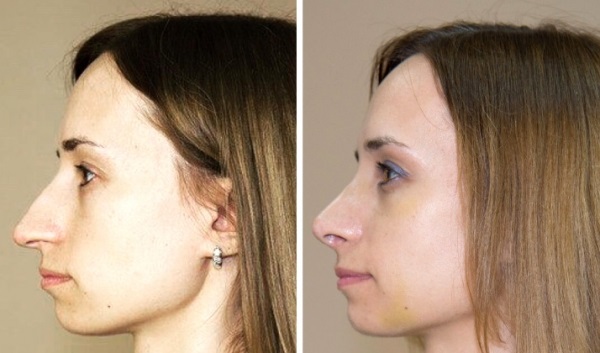
Correction of the nose occupies one of the main positions in the statistics of visits to plastic surgeons. To minimize the risks of complications after the operation, it is necessary to choose a cosmetic-type clinic with a proven reputation.
| Medical centers in Moscow | Operation type, price |
| "Medicine 24/7" |
|
| "Medical center K + 31" |
|
| "Gradient" |
|
| clinic "Capital" |
|
| Scientific and Practical Center for Surgery |
|
In St. Petersburg:
- "Grandmed" (reduction of the nasal septum, correction of defects obtained in a natural way 70,000 to 120,000 rubles);
- "Medestetic" (laser rhinoseptoplasty from 85,000 rubles);
- "Scandinavia" (rhinoplasty, correction of parts of the nose, changing the shape of the nose from 92,000 rubles).
The Moscow branch of the Stolitsa clinic has been opened in Krasnoyarsk, where Moscow specialists are receiving appointments. Operations to correct the shape of the nose are carried out as planned, the recording is carried out at the clinic's registry The cost of rhinoseptoplasty for congenital defects is from 120,000 rubles.
In Krasnodar, the services of plastic surgeons are offered by the South-Russian center of cosmetology:
- primary rhinoplasty - 138,000 rubles;
- secondary plastic surgery of the nose with correction and correction - 156,000 rubles.
Plastic nose correction is a surgical procedure with all possible risks of complications. The decision to perform rhinoseptoplasty should be individualized; such a decision should be made after a full examination and consultation with a specialist. When planning, one should take into account the terms of plastic surgery and the period of rehabilitation.
Useful videos about rhinoseptoplasty and its results
Surgeon about rhinoseptoplasty:
Choosing between septoplasty and rhinoseptoplasty:

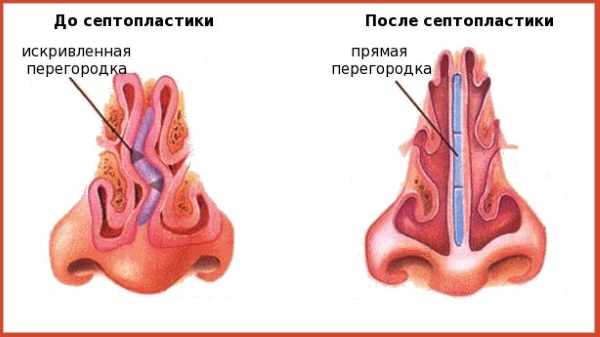

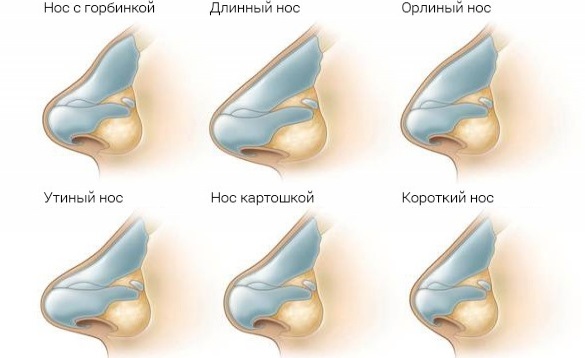
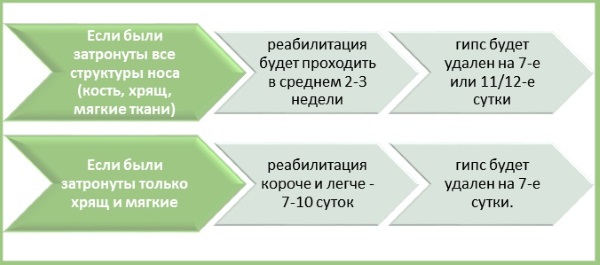
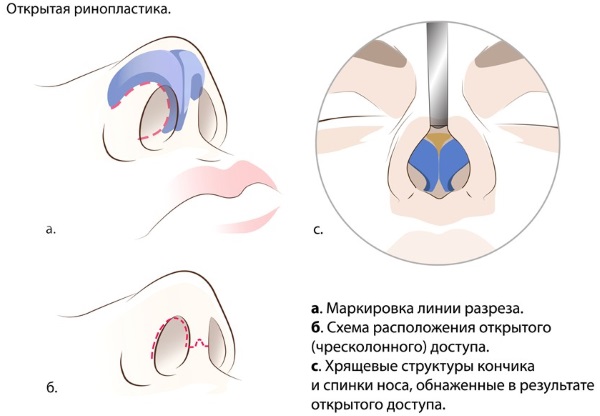
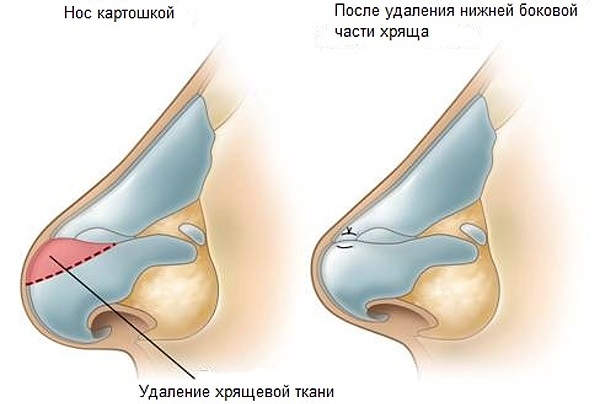
My septum is slightly curved, it greatly interferes with breathing. I'm thinking about an operation. Thanks for the detailed article.